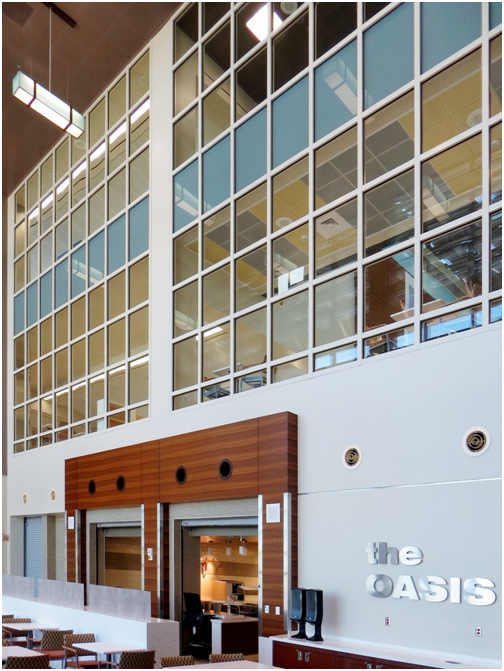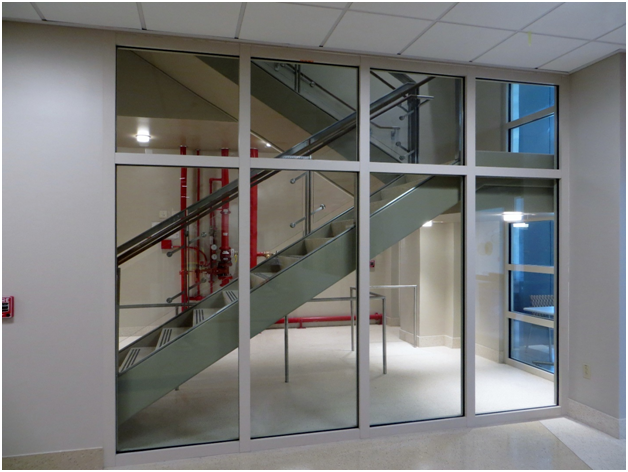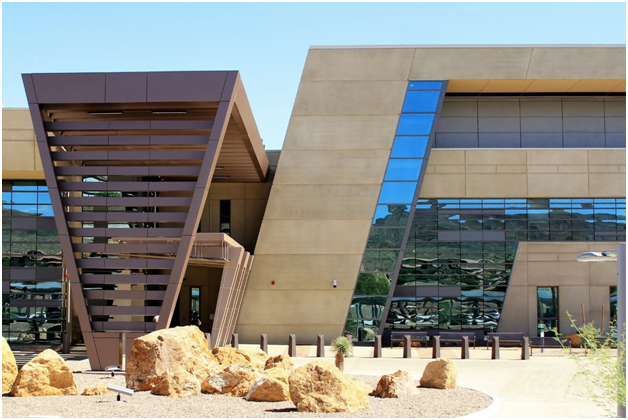The Department of Defense (DoD) published the Unified Facilities Criteria (UFC) 4-010-01 Antiterrorism Standards for Buildings as a mandatory guideline to mitigate the threats of terrorism against buildings and ensure the safety of the individuals that inhabit them. It applies to all newly constructed DoD Components, DoD inhabited buildings, billeting and high-occupancy housing, as well as already inhabited buildings where the renovation costs are 50% or more than the value of the building (for a complete list, please see UFC 4-010-01 section 1.8).
One of the areas that the UFC standard addresses in great detail is blast hazard mitigation, particularly in window systems, due to the fact that the majority of the damage and injuries are caused by high velocity glass fragments on people in the building or in the vicinity when a blast occurs. SAFTI FIRST became very familiar with the DoD’s blast requirements when they were selected by the architects to supply a fire resistive, blast rated curtain wall for an Army Hospital in the West Coast.
The fire resistive, blast rated curtain wall in this medical facility is located near a drive-up/drop off area, which typically is exempt from building hardening requirements (see Section B-1.3). However, since this Army Hospital is classified as a critical facility – defined in Section 1-7.3 as “buildings that must remain operational during periods of national crisis and may be subjected to a terrorist attack may warrant design to higher levels of protection that those provided in these standards” – the following blast ratings were required by the army:
- Provide laminated glass with a minimum interlayer thickness of 0.030 in. (0.75 mm) with a load resistance determined by ASTM E1300 greater or equal to the 3-second duration equivalent design load determined from ASTM F2248.
- In accordance with ASTM F2248, ensure that the framing members restrict deflections to 1/160 of the length of the supported edge at allowable stress levels under the equivalent 3-second design loading of 50 lbs. psf.
- The connection design will be determined in accordance with ASTM F2248 based on two times the equivalent 3-second design loading of 50 lbs. psf.
Sections of the blast rated curtain wall also had to meet a 2-hour, ASTM E-119 fire resistive rating per Section 1023.7 of the IBC, which says:
“… Where nonrated walls or unprotected openings enclose the exterior of stairways or ramps and the walls or openings are exposed by other parts of the building at an angle of less than 180 degrees (3.14 rad), the building exterior walls within 10 feet (3048 mm) horizontally of a nonrated wall or unprotected opening shall have a fire resistance rating of not less than 1 hour.”
In addition to the blast and fire resistive performance, the curtain wall system also had to meet windload requirements, static and dynamic water testing, air infiltration testing as well as thermal movement requirements. The design of the fire resistive, blast rated curtain wall system was also a challenge. The design called for a glass and framing system that spanned 45 feet and canted out a few degrees.
With all these performance and design requirements, it was clear that the architects and the US Army were looking for fire rated systems manufacturer with unique fabrication capabilities that could deliver a high-performance, custom-engineered curtain wall system. After reviewing several proposals, the design team chose SAFTI FIRST to deliver the solution they desired.
SAFTI FIRST supplied the GPX Blast System, a complete fire resistive, blast rated, aluminum curtain wall manufactured and fabricated in Merced, CA. The GPX Blast system uses custom ASTM E-119 rated, fire resistive SuperLite II-XL glazing with one tempered and laminated lite with a minimum interlayer of 0.030 in. designed in accordance with ASTM F2248: Standard Practice for Specifying an Equivalent 3-Second Duration Design Loading for Blast Resistant Glazing Fabricated with Laminated Glass. It also meets a 3-second design loading of 50 lbs. psf per UFC 4-010-01 and ASTM E1300: Standard Practice for Determining Load Resistance of Glass in Buildings.
The GPX Blast System can be engineered to meet all levels of blast protection depending on the project, with static and dynamic analysis using Wingard software, which is standard industry practice and allowable under DoD standards. It is also offered in standard and custom finishes including high performance fluoropolymer finishes by PPG, clear anodized, bronze anodized, black anodized, Decoral, any species of wood veneer, ornamental metal, and more.
SAFTI FIRST also supplied SuperLite II-XL 60 and 120 in GPX Architectural Series framing for the stairwells and atriums, which incorporated warm gray spandrel glass for a decorative effect.
 1 hour fire resistive atrium walls with SuperLite II-XL 60 in GPX Architectural Series framing. Some units incorporated warm gray spandrel glass for a decorative effect.
1 hour fire resistive atrium walls with SuperLite II-XL 60 in GPX Architectural Series framing. Some units incorporated warm gray spandrel glass for a decorative effect.
 2 hour fire resistive stairwells with SuperLite II-XL 120 in GPX Architectural Series framing.
2 hour fire resistive stairwells with SuperLite II-XL 120 in GPX Architectural Series framing.
Because this was a high-security project, SAFTI FIRST’s project management team worked with the construction team to ensure that all the schedules were met and that appropriate security clearances were obtained to ensure smooth and timely delivery of all product being supplied.
The result is an elegant, high-performance solution that met both the aesthetic, security and performance requirements of a modern Army Hospital that promotes healing for the brave men and women who serve our country.
Related Stories
| Feb 10, 2011
7 Things to Know About Impact Glazing and Fire-rated Glass
Back-to-basics answers to seven common questions about impact glazing and fire-rated glass.
| Oct 11, 2010
MBMA Releases Fire Resistance Design Guide for metal building systems
The Metal Building Manufacturers Association (MBMA) announces the release of the 2010 Fire Resistance Design Guide for Metal Building Systems. The guide provides building owners, architects, engineers, specifiers, fire marshals, building code officials, contractors, product vendors, builders and metal building manufacturers information on how to effectively meet fire resistance requirements of a project with metal building systems.
| Aug 11, 2010
AAMA leads development of BIM standard for fenestration products
The American Architectural Manufacturers Association’s newly formed BIM Task Group met during the AAMA National Fall Conference to discuss the need for an BIM standard for nonresidential fenestration products.
| Aug 11, 2010
Pella Corporation ranks highest in customer satisfaction
Pella Corporation has earned the prestigious J.D. Power and Associates award for “Highest in Customer Satisfaction among Window and Patio Door Manufacturers” for the third year in a row.
| Aug 11, 2010
Pella introduces BIM models for windows and doors
Pella Corporation now offers three-dimensional (3D) window and door models for use in Building Information Modeling (BIM) projects by architects, designers, and others looking for aesthetically correct, easy-to-use, data-rich 3D drawings.
| Aug 11, 2010
AAMA developing product-based green certification program for fenestration
The American Architectural Manufacturers Association is working on a product-based green certification program for residential and commercial fenestration, the organization announced today. AAMA will use the results of a recent green building survey to help shape the program. Among the survey's findings: 77% of respondents reported a green certification program for fenestration would benefit the product selection process for their company.








